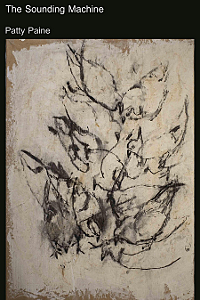 The Sounding Machine
The Sounding Machine
by Patty Paine
Accents Publishing, 2012
71 pages / $12.00 buy from Accents Publishing
1. “Still” is a poem about a girl, in her stepfather’s bedroom, holding the “unspooled” film of frames showing “Linda Lovelace’s bottomless / throat” against “curtained light.”
2. The girl’s ears are “cocked / for gravel beneath tires.”
3. She is afraid that her stepfather will return, angry.
4. “Still” is a poem about abuse, and how the memory of that abuse is wrapped and “swallowed” like the “first flash of desire”; that “chasm / of silence, her mouth.”
5. “Still” is not the first poem of The Sounding Machine, but the one I returned to the most. Paine’s collection accumulates, but “Still” is the best pivot.
6. The Sounding Machine hurts.
7. This is a book about grief, focused on the loss of a mother. So Nyo Kim. A woman who married an American soldier during the Korean War. The narrator of many poems in this collection–apparently So Nyo’s daughter–is nearly peeling with this grief.
8. “Sometimes I stop looking/ in mirrors.” “Sometimes I feel / like a child with holes / in my pockets, every day losing / some small stone of myself.”
9. The Sounding Machine made me feel, but Paine was also able to control me, to wire me shut with words. “Ars Poetica” warns that “there are days / when language is heavy furniture you push around / a house made of nothing / but hallways.” The narrator admits “sometimes a poem can lie.”
10. But I want to believe her lies.
11. That’s a comfortable poetic paradox to experience, as a reader: a poet placing the strings on the table, showing you the method of control, but confident that you will react regardless.
12. Paine’s control extends toward practical notes, including her associations within single narratives. “Vantage” begins with a prisoner “constructing elaborate mazes / on the floor with match sticks.” A “thin trail / of sugar” leads toward a puddle of Tabasco. The ants pile in the puddle, becoming bridges so that other ants can complete the trek. Paine juxtaposes this bridge of bodies with another, at Hiroshima, where the mushroom cloud “[leads] the eye higher, until / the man excusing himself / for bumping dead bodies / as he stumbles naked / down the street is almost / too small to see.”
13. Paine devalues neither element of the analogy.
14. In an 1815 advertisement for his sounding machine, Edward Massey claimed that invention, along with his chronometer and perpetual log, were “the most important inventions ever introduced into navigation.” Massey was a watchmaker. Sounding machines measured water depth. Water, depth, watches, dials, brass, Massey, sounding.
15. Paine’s collection is not nautical.
16. But her focus is on the depths of grief, and how the poetic act, an act where mythmaking and lying is endemic to the construction of narrative, might be a way to pursue unfinished melancholy. Paine drops the wire of her sounding machine to the bottom of the ocean, but she doesn’t pull it back up: she drags it along, fogging the water.
17. Folded into the middle of the collection is a chapbook-length sequence or prose poems, titled Oracle Bones, the original title of the entire book. The poems focus on Robert, that American soldier, and So Nyo. Paine has already prepared the reader for lying, but some sentences and moments ring so authentic: “I’m not saying I’m proud, but it’s true that I stood next to So Nyo’s hospital bed in my dress A’s, my eyes fixed on the tips of my shoes, and told her I wanted a divorce in front of the priest waiting to administer Last Rites and Absolutions.”
18. “My girls are lost to me.”
19. The Sounding Machine wonders what happens when men are terrible, or absent, or both. When “what’s missing has a language / of it’s own.” When a woman can be an “empty machine.”
20. When the narrator is that empty machine, she lies in the man’s bed, and her “body slips / into the groove his body made.”
21. Why allow this man, this stepfather, to control the identity of these women? The same man who “hurled our mother’s / huge ceramic elephant / through the living-room window”?
22. And was that flying ceramic elephant even real? Did the EMTs really have “a running bet” of “how many trips to the Paines’ per month”? Was there really “no park, no / red-tailed hawk, no bus ride”?
23. Does that matter, if “everything / else is true”?
24. “I wanted this poem / to have such terrible momentum it would rip / tide you through until you were battered.”
25. That has been accomplished.
—
Nick Ripatrazone is the author of four books: This Darksome Burn, The Fine Delight: Postconciliar Catholic Literature, This Is Not About Birds, and Oblations.
Tags: 25 Points, Accents Publishing, Patty Paine, The Sounding Machine
